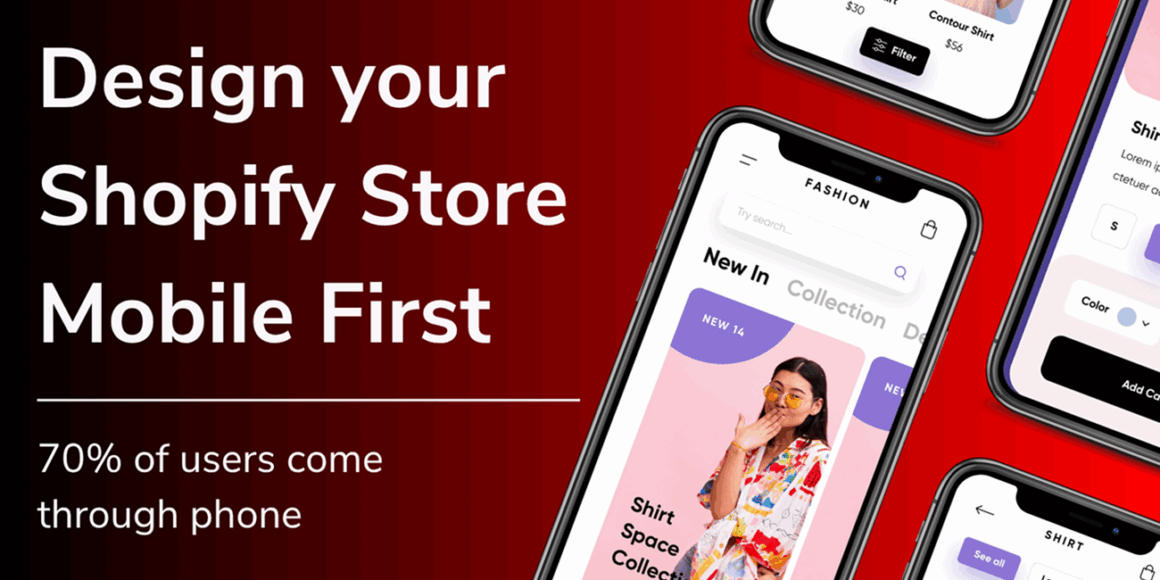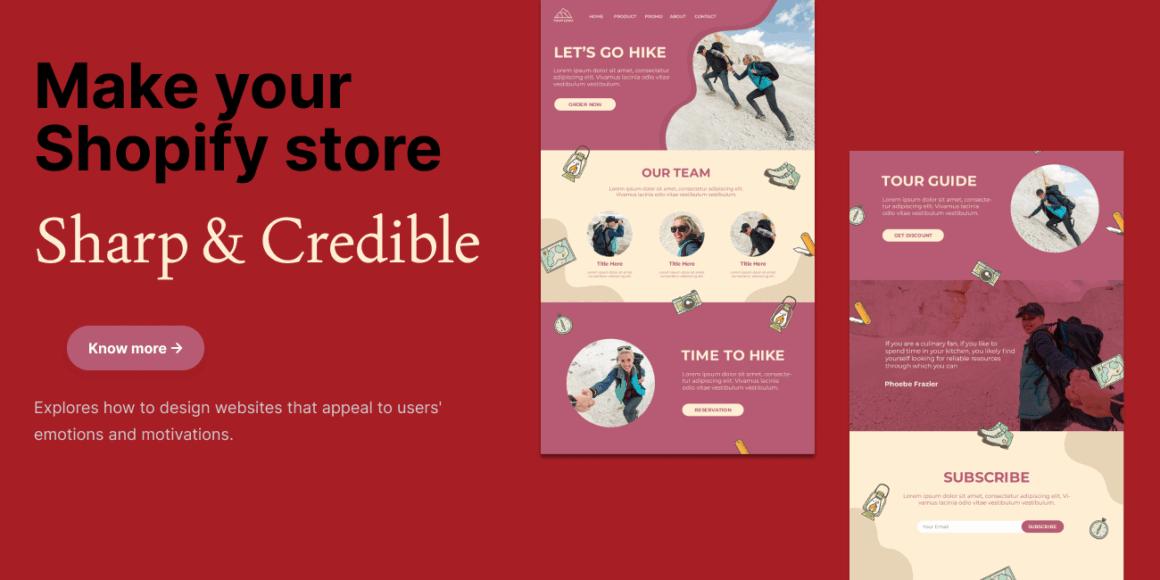Opening your Shopify store is a big step exciting, empowering, and full of potential. But what if it’s not delivering the results you hoped for?
Sometimes, even amazing products can struggle in an underperforming store. Poor user experience, technical hiccups, or missed opportunities can quietly kill your conversions.
1. Low Conversion Rate (Lots of Traffic, Few Sales)
You’re getting visitors, but barely anyone is buying. That’s a red flag.
A low conversion rate often means your store isn’t convincing enough — whether it’s due to unclear calls to action, a confusing layout, slow trust-building, or a lack of urgency. Great products alone aren’t enough — your store must guide and reassure buyers to the finish line.

The Solution:
- Make your calls to action (CTA) bold, clear, and actionable to direct users effectively and reduce confusion, boosting conversions.
- Simplify your navigation so customers can find products effortlessly, enhancing their buying journey and reducing bounce rates.
- Add trust elements like reviews, testimonials, security badges, and clear return policies to build credibility and increase purchase confidence.
- Test your pricing strategy and offer incentives like limited-time discounts or free shipping to encourage quicker purchases and increase urgency.
Pro Tip:
Use heatmaps and visitor session recordings to see exactly where users are dropping off.
2. High Cart Abandonment Rate
Customers are adding products to the cart but vanishing before they pay.
This often points to checkout roadblocks: surprise shipping costs, lack of payment options, too many steps, or even trust issues at the final stage. If your cart abandonment rate is high, you’re likely leaving money on the table daily.
The Solution:
- Offer transparent shipping costs upfront to avoid checkout surprises and reduce abandonment.
- Provide multiple payment options (PayPal, credit cards, buy-now-pay-later options) to accommodate more customers and remove payment friction.
- Simplify the checkout process — fewer steps = fewer drop-offs, which leads to faster conversions.
- Add abandoned cart recovery emails with incentives like a 10% discount to recapture lost sales and boost revenue.
Pro Tip:
Use urgency tactics (like “Only 2 left in stock!”) but keep it honest to maintain trust.
3. Slow Site Speed and Performance
If your site takes more than 2–3 seconds to load, many visitors won’t wait.
Speed isn’t just about user experience — it impacts your SEO, bounce rate, and conversion rate. Images that aren’t optimized, uncompressed files, or poorly built themes can bog down performance, especially on mobile devices.
The Solution:
- Compress all images without sacrificing quality to improve speed and keep visual appeal intact.
- Remove unnecessary apps and scripts slowing down your site to create a faster, smoother browsing experience.
- Choose a lightweight, optimized theme for better load times and improved user engagement.
- Use Shopify’s built-in performance tools or third-party apps to monitor site speed so you can identify issues before they cost you sales.
Pro Tip:
Test your store speed regularly on mobile and desktop using Google PageSpeed Insights.
4. Poor or Cluttered Mobile UX
With more than 70% of traffic coming from mobile, your site MUST be mobile-optimized.
If your mobile layout is messy, buttons are hard to click, or the page takes too long to scroll or load — users will exit instantly. A responsive, thumb-friendly, clean mobile experience is no longer optional — it’s essential.
The Solution:
- Choose a responsive, mobile-first theme to ensure a seamless shopping experience on all devices.
- Keep buttons big and thumb-friendly to reduce frustration and improve mobile usability.
- Reduce pop-ups that cover essential content to keep users focused and avoid drop-offs.
- Ensure smooth scrolling and faster loading on mobile devices to hold attention and lower bounce rate.
Pro Tip:
Test your site on different devices (iPhone, Android, tablet) to find and fix issues before your customers do.

5. Low Customer Retention
One-time buyers who never come back? That’s a missed opportunity.
A strong store builds relationships — through post-purchase emails, loyalty programs, upsells, or simply delivering an unforgettable brand experience. Without these, you’re always chasing new customers instead of nurturing the ones you’ve already earned.
The Solution:
- Send thank-you emails and personalized post-purchase follow-ups to make customers feel valued and encourage repeat purchases.
- Create loyalty programs that reward repeat purchases to build long-term engagement and increase lifetime value.
- Introduce subscriptions or membership models if possible to ensure consistent revenue from repeat buyers.
- Regularly update customers with fresh content, offers, and launches to keep them engaged and returning.
Pro Tip:
Retention can dramatically boost profits — sometimes up to 80% more than focusing only on new customers.
6. SEO Misconfigurations
Your products are amazing, but no one can find them.
Many stores forget the basics: unique meta titles, keyword-rich descriptions, image alt text, structured data. Without proper SEO, you’re invisible to Google — and missing out on consistent, organic traffic that converts.
The Solution:
- Write unique meta titles and descriptions for every product and page to stand out in search results and improve click-through rates.
- Use keyword-rich product titles and descriptions without sounding robotic to boost search visibility while keeping content user-friendly.
- Add image alt texts for better accessibility and SEO to make your store discoverable through image search too.
- Implement structured data (schema markup) for rich search results to enhance how your store appears in Google and drive more clicks.
Pro Tip:
Consistent SEO efforts compound over time — it’s a marathon, not a sprint!
7. Weak Branding
If your store feels generic or inconsistent, it’s hard for shoppers to trust you.
Effective branding isn’t just about a logo or color scheme — it’s about tone, personality, and emotion. A strong brand builds recognition and loyalty, while a weak one blends into the crowd.
The Solution:
- Define a clear brand voice and tone to create a memorable and relatable identity.
- Use a cohesive color palette, logo, and typography across the site to increase brand recognition and professionalism.
- Share your brand story: why you exist and what you believe in to emotionally connect with your audience.
- Highlight your unique selling proposition (USP) clearly on your homepage to differentiate your brand and win trust quickly.
Pro Tip:
People don’t just buy products; they buy brands they trust and feel connected to.
8. High Return Rates and Refund Requests
When too many orders come back, there’s usually a gap in expectation vs. reality.
This could be due to unclear product descriptions, misleading photos, missing size guides, or vague shipping policies. Not only does it hurt revenue, it also erodes customer trust.
The Solution:
- Write detailed, honest product descriptions to set accurate expectations and reduce returns.
- Use high-quality images and, if possible, videos showing the product in real life to give customers more confidence in what they’re buying.
- Provide sizing charts, material info, and care instructions clearly to minimize purchase mistakes.
- Set clear shipping, return, and refund policies to create transparency and avoid misunderstandings.
Pro Tip:
Consider customer feedback on returns seriously — it’s a goldmine for improving product pages.
9. Theme Limitations
Shopify’s default themes are great starting points — until they’re not.
As your store grows, you’ll want unique features, custom flows, or scalable integrations. If your theme can’t keep up with your ideas, you’ll feel stuck — and so will your customers.
The Solution:
- Upgrade to a more flexible premium theme if needed to gain access to advanced features and scalability.
- Consider custom theme development for complete freedom to create a unique shopping experience aligned with your vision.
- Invest in modular design systems that can scale with your product offerings to ensure flexibility as your catalog grows.
Pro Tip:
A good theme isn’t just about aesthetics — it’s about user journey optimization.
10. Paying for Shopify Advanced or Plus, But Not Using It
You’ve invested in a premium Shopify plan — but are you getting the value?
Features like custom checkout, automation workflows, advanced analytics, and exclusive integrations are game-changers. If you’re not leveraging them, you’re wasting potential and budget.
The Solution:
- Implement automation workflows like customer segmentation and follow-up emails to save time and deliver personalized marketing.
- Customize your checkout experience to improve conversion by tailoring it to your brand and user needs.
- Use advanced analytics to make smarter decisions based on real data to identify trends and fine-tune your marketing.
- Explore B2B features if you’re selling wholesale too to tap into new revenue streams and partnerships.
Pro Tip:
If you’re unsure how to fully utilize Shopify Plus/Advanced, consider hiring an expert partner to maximize your ROI.
Let’s Fix What’s Not Working — Together.
If you’ve spotted a few red flags in your store, don’t stress — you’re not alone.
The good news? 18pixels is here to help you fix, optimize, and elevate your store.
We don’t just build stores — we craft high-converting Shopify experiences tailored to your brand. From sleek UI/UX and fast mobile performance to SEO, integrations, and brand strategy — we turn underperforming stores into success stories.
Don’t settle for average results. Unlock your store’s full potential.
Book a free consultation today!
Have a Project in Mind? Let’s Talk!
🚀 Get in touch now – we’re just a click away.
🌐 Visit us: www.18pixels.com
📩 Email: [email protected]
📞 Call Us: +91-9511120332
Don’t stop here—discover more in our latest blog –
18Pixels Nonprofit CRM Solutions
Software Solutions for Business Success
